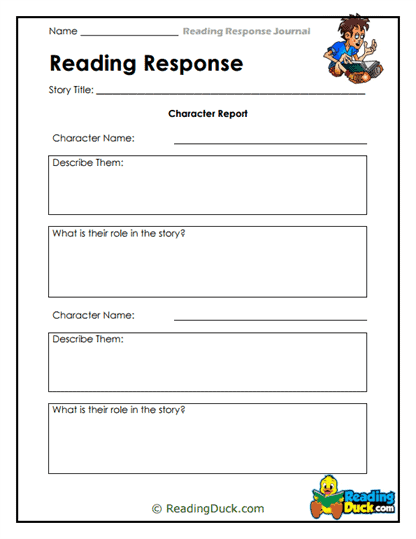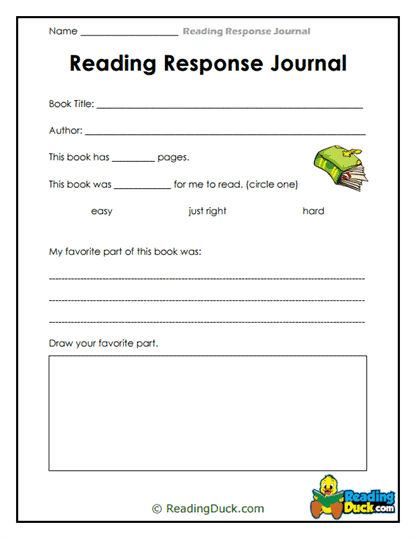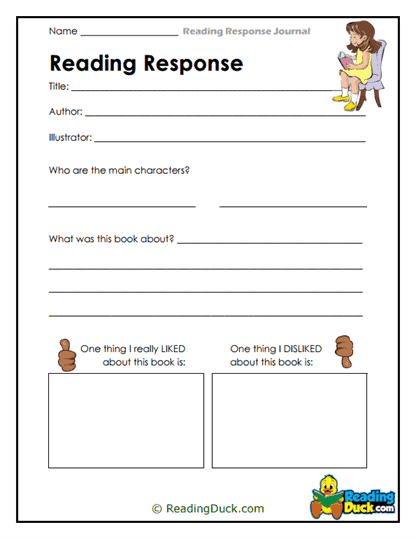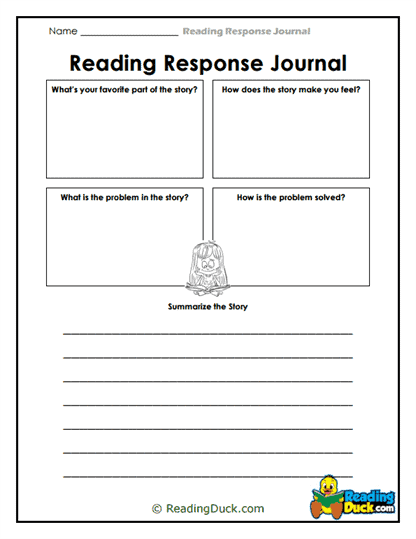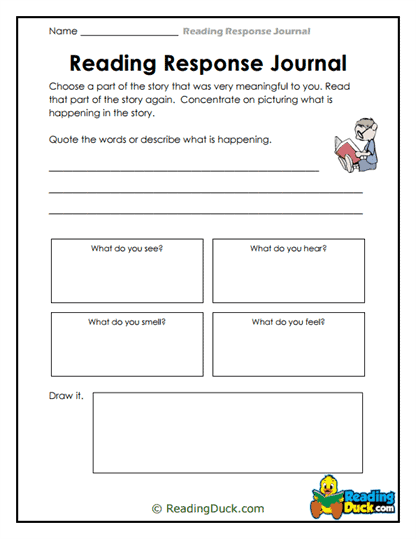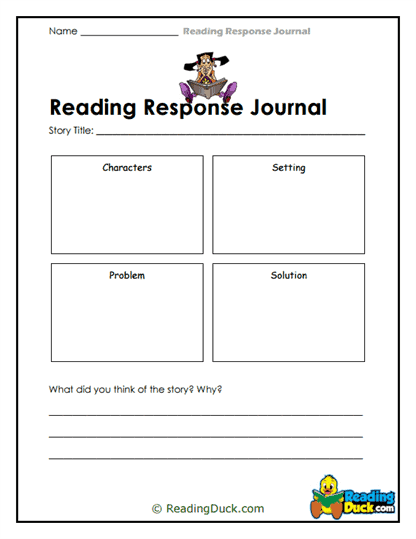Reading Response Journals Worksheets
About Our Reading Response Journal Worksheets
Our Reading Response Journals Worksheets are a dynamic and interactive collection designed to enhance early literacy skills in young learners. This collection is a part of the 'Phonics' category within the 'Pre-Reading' section, offering a foundational tool for developing critical thinking and comprehension abilities through guided journaling activities.
These worksheets are presented in a user-friendly PDF format, making them simple to view, download, and print for both classroom and home use. Each worksheet is accompanied by a downloadable answer key, facilitating easy assessment and feedback for educators and parents alike. The worksheets are structured to engage students in reflective reading practices, encouraging them to articulate their thoughts, make connections, and deepen their understanding of the texts they encounter.
Understanding Reading Response Journals: A Comprehensive Analysis
Reading Response Journals are an essential component of early literacy instruction, particularly within the framework of phonics and pre-reading activities. These journals provide young learners with an opportunity to engage with texts on a deeper level, promoting active reading and critical thinking. By writing down their thoughts, feelings, and responses to what they read, students begin to develop a habit of thoughtful reflection, which is crucial for their overall literacy development.
What Are Reading Response Journals?
Reading Response Journals are tools that allow students to record their personal reactions to texts. These journals serve as a space where students can explore their thoughts about a story, ask questions, and make connections between the text and their own experiences. The process of writing in a response journal helps students to:
- Reflect on Content: Students can think about what they have read and express their understanding of the text in their own words. This reflection helps solidify comprehension.
- Express Emotions: Journals allow students to explore and articulate their emotional responses to the text, which can be particularly engaging for young readers.
- Make Connections: Students are encouraged to draw connections between the text and their own lives, other books, or broader world concepts. This helps to deepen their understanding and make reading more relevant to them.
- Develop Writing Skills: Regular journaling practice helps students improve their writing abilities, as they learn to organize their thoughts and convey their ideas clearly.
Importance of Reading Response Journals
The use of Reading Response Journals in early literacy instruction is invaluable because it encourages active engagement with the text. Unlike passive reading, where students may simply absorb information, response journals require them to think critically about what they are reading. This active involvement enhances comprehension and retention, making the reading experience more meaningful and impactful.
Examples of How Reading Response Journals Work
For example, after reading a short story, a student might be prompted to answer questions such as:
- What was your favorite part of the story? Why?
- How did the main character feel during the story? How do you know?
- Have you ever felt the same way as the character? When?
These types of questions encourage students to not only recall details from the story but also to reflect on their personal connections to the text, thus deepening their comprehension and making the reading experience more interactive.
Overcoming Challenges in Using Reading Response Journals
While Reading Response Journals are highly beneficial, some students may encounter challenges when learning to use them effectively. These challenges can range from difficulty in expressing thoughts in writing to a lack of motivation to engage with the text deeply.
Common Challenges
- Writing Reluctance: Some students may feel intimidated by the prospect of writing, especially if they struggle with spelling, grammar, or organizing their thoughts.
- Lack of Engagement: Young students may sometimes find it challenging to engage deeply with the text, especially if they are not naturally reflective or if they do not find the text interesting.
- Difficulty in Expressing Emotions or Thoughts: Students may struggle to articulate their feelings or thoughts about a text, leading to shallow or incomplete journal entries.
Strategies for Success
To help students overcome these challenges, educators can employ several strategies that make the journaling process more accessible and enjoyable:
- Modeling and Examples: Teachers can model how to write a response journal by sharing their own entries or using examples of well-written student responses. This provides a clear framework for students to follow.
- Sentence Starters: Providing sentence starters can help students who struggle with how to begin their journal entries. Examples include, “I was surprised when…”, “I didn’t understand why…”, or “This story reminds me of…”.
- Incorporate Art: For students who find writing challenging, integrating drawing into their response journals can be a useful tool. For instance, they might draw a scene from the story and then write a few sentences explaining their picture.
- Encourage Oral Discussions: Before writing, allow students to discuss their thoughts about the text with a partner or in a small group. This verbal processing can make it easier for them to organize their thoughts before writing.
The Role of Reading Response Journals in Phonics and Literacy Development
Reading Response Journals play a significant role in phonics and overall literacy development, particularly in the early stages of reading. They help bridge the gap between decoding words and understanding texts by promoting deeper engagement with reading material.
How Reading Response Journals Support Phonics
- Reinforcing Phonics Skills: As students write in their journals, they apply the phonics rules they have learned, reinforcing their understanding of letter-sound relationships. This practice helps solidify their decoding skills as they connect sounds to words in the context of meaningful sentences.
- Enhancing Vocabulary: Journaling provides an opportunity for students to use new vocabulary words they encounter in their reading. This active use of vocabulary aids in retention and helps expand their language skills.
- Building Comprehension: By reflecting on and writing about the texts they read, students enhance their comprehension skills. This process encourages them to think critically about the story's events, characters, and themes, leading to a deeper understanding.
Supplementary Activities to Pair with Reading Response Journals
To maximize the effectiveness of Reading Response Journals, educators can incorporate a variety of supplementary activities that enhance the journaling experience and provide additional opportunities for students to practice their literacy skills.
Suggested Activities
- Book Discussions: After completing a journal entry, students can participate in a group discussion about the book. This allows them to share their thoughts, compare responses, and gain new insights from their peers.
- Story Mapping: Have students create a visual story map before writing in their journals. This can include the setting, characters, problem, and solution, helping them to organize their thoughts and understand the story structure.
- Reader’s Theater: Engage students in a reader’s theater activity based on the text they have read. After performing, students can reflect on their experience in their journals, discussing how acting out the story helped them understand it better.
- Pair Journaling with Art: Encourage students to illustrate a scene or character from the text and then write a journal entry explaining their drawing. This activity is particularly useful for younger students or those who are more visually inclined.
- Interactive Journal Sharing: Allow students to pair up and share their journal entries with a classmate. This not only builds confidence but also exposes them to different perspectives and interpretations of the text.
These activities are particularly suitable for kindergarten through second-grade students, who are in the early stages of developing their reading and writing skills. However, they can be adapted for older students as well, depending on their literacy level and needs.
Building Confidence Through Mastery of Reading Response Journals
Mastery of Reading Response Journals is a powerful way for students to develop confidence in their reading and writing abilities. By regularly engaging with texts through journaling, students learn to articulate their thoughts, make connections, and express their understanding in a structured way.
Why Reading Response Journals Are Vital in Learning Curriculums
Reading Response Journals are vital because they encourage students to become active participants in their reading journey. This active engagement is crucial for developing critical thinking skills, which are necessary for academic success. Furthermore, as students become more comfortable expressing their thoughts and feelings about texts, they develop a greater sense of ownership over their learning. This ownership translates into increased motivation, leading to a more positive attitude toward reading and writing.
In summary, Reading Response Journals are a key component of early literacy instruction that fosters deeper comprehension, critical thinking, and a love of reading. By mastering this skill, students not only improve their phonics and writing abilities but also build the confidence needed to succeed in all areas of literacy. This topic is vital in learning curriculums because it supports the development of thoughtful, reflective readers who are prepared to engage with texts in meaningful and impactful ways.
